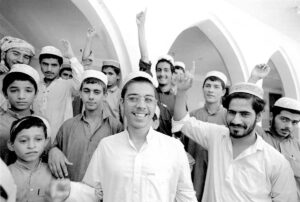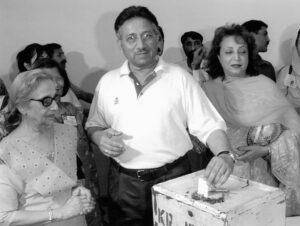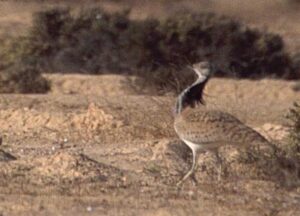The timing hardly seemed fortuitous. On May 1st, only 24 hours after a controversial referendum in Pakistan, which allowed General Pervez Musharraf to extend his Presidency for an additional five years — and, in the process, stripped away the country’s last façade of constitutional rule — Pakistani officials acknowledged that U.S. ground forces would be permitted to operate inside Pakistan. Their objective: to pursue or ferret out members of al-Qaeda — and perhaps even Osama bin Laden himself — who were believed to be regrouping here, in the craggy mountains and rolling hills on both sides of the Pakistan-Afghan frontier. One Pakistani intelligence official told me that some three thousand or more al-Qaeda fighters and members of the Taliban had slipped across the Afghan border into Pakistan — most of them through the tribal areas of the North-West Frontier Province and Balochistan. Even bin Laden himself had been spotted twice in recent weeks, an Afghan intelligence official told the press, just across the border in Pakistan’s tribal area of North Waziristan. But diplomatic and strategic constraints had kept the al-Qaeda vanguard beyond the reach of U.S. troops, something that had led to growing frustration, and irritation, in Washington. Musharraf would permit the Americans access, but on his terms.
The General was thus most distressed, one of his advisers said to me, when tribal elders announced to the Pakistani press — two weeks before his government even acknowledged that U.S. ground forces might become militarily involved in Pakistan at all — that some forty U.S. commandos were already there, in the tribal lands of North Waziristan. They were operating from a command center in Miram Shah, a dusty little border town and gateway to Pakistan’s tribal lands — lands which have been ruled by tribal law since the days of the British Raj and which, now and then, were well beyond the central government’s writ.
The question of permitting U.S. forces a visible presence there had been hotly debated for months by General Musharraf’s army-backed government. Indeed, from the very beginning of Pakistan’s involvement in Washington’s newest Afghan war, strains in the relationship between Washington and Islamabad had begun to occur: over the length of Washington’s bombing of Afghanistan; the composition of a broad-based government there — as well as whether U.S. troops would be permitted to operate inside Pakistan. Indeed, the strains had become palpable enough that, by the spring, the question being increasingly asked of the new Pakistani-American relationship was: How long will it last?
For since Musharraf — at the strong urging of Washington — made a forceful address to the nation on January 12th in which he condemned Islamic extremism, banned five extremist groups, and ordered some 2,000 arrests, the Pakistani General has steadily backed down. Of those arrested, seventy-five per cent have been released. And of the banned groups, Lashkar-i-Taiba has been reborn as Jamaat-ad-Dawa, and the magazine Soldiers of Mohammed (published by the group of the same name, the Jaish-e-Mohammed) is now called Al-Islah, or Reform. For the extremist groups, which have long formed part of the fabric of Pakistan’s political cloth, have powerful supporters within Musharraf’s Army establishment, most importantly, within his military intelligence organization, Inter-Services Intelligence, or I.S.I., which, paradoxically perhaps, had been the primary benefactor of the militant Islamist groups for years. As a result, the agreement to allow American forces to pursue bin Laden’s fighters inside Pakistan seemed a trade-off — as long as Pakistan’s equally militant fighters were left untouched.
There was a sense of déjà vu by the early days of May, 2002. For not only was the United States back in Pakistan, and, even more obviously, in Afghanistan, but the mujahideen armies, the warlords, and tribal chiefs whom Washington had sponsored twenty years before, to such disastrous effect, during the jihad of the 1980s against the Soviet occupation of Afghanistan, had largely been returned to power there — by the United States.
Yet, there had been discernible changes over the years, as the initial ambivalence of Pakistan’s generals showed. The generals’ constraint, in the face of Washington’s demands, was based, in large part, on their growing fear of a violent backlash either among the burgeoning number of Islamic hard-liners within their own Army officer corps or from the dozen or so private Islamist armies, based in Pakistan, whose numbers had proliferated over recent years. Too close an association with the United States could lead to insurrection by either of these groups, or insurrection by a combination of the two.
For years, Pervez Musharraf was known in the Army as “the cowboy,” because of his Westernized ways. The irony is that the cowboy was brought to power by an Army that has become increasingly anti-American and fundamentalist. And, if that Army found increasing common cause with the country’s militant Islamist groups, the two came together over recent years, most self-consciously, in the former princely state of Kashmir — a Muslim-majority state which both Pakistan and India claim, and which has been divided between them for more than half-a-century. And although Kashmir is a battle that neither India nor Pakistan can win militarily, it is a battle that neither can loose politically.
As a result, what began as an indigenous, secular movement for Kashmiri independence more than a decade ago has increasingly become an Islamist crusade to bring all of Kashmir under Pakistani control. According to a State Department official, forty per cent of the militants fighting Indian troops in Kashmir are not Kashmiris: they are Pakistanis and Afghans. Virtually all of them belong to the dozen or so private Islamist armies based in Pakistan, which are offshoots of earlier groups launched, during the 1980’s, by American and Pakistani intelligence, during the jihad. At least a hundred and twenty-eight military training camps now dot the valleys and mountains of Pakistan. More than a thousand eager young men pass through them each year, joining the ranks of some sixty to a hundred thousand Islamic militants who fought or trained in Afghanistan and then, well-armed, were dispatched to Kashmir, or returned home to Pakistan. They were once proxies of various Pakistan governments which, since the days of the country’s last military ruler, General Mohammed Zia ul-Haq, have used and nurtured Islamic militancy for reasons of state. Thus far, Musharraf’s military regime has been unable, or unwilling, to rein them in.
The Bush (and earlier the Clinton) Administration had demanded that Musharraf do this. But Musharraf is beholden to his fellow-generals, who carried out the country’s October, 1999 coup in his name. And the men on the ground, who secured the capital of Islamabad and Karachi Airport — as General Musharraf, for all intents and purposes, was held captive in a commercial airliner which was not permitted to land — are generally more religious, and even more hawkish toward India, than he is. Some are Islamic hard-liners and the line dividing them from the radical Islamists — whose ranks include a significant number of retired Army officers —who trek across the mountains into Indian-controlled Kashmir, is a line that is becoming increasingly blurred.
Both supporters and detractors of General Musharraf say that much of the responsibility for this lies with the United States. In October of 1990, only nineteen months after the jihad in Afghanistan came to an end, the first Bush Administration cut off all military and most economic aid to Pakistan because of its program to develop a nuclear weapon — something that had been largely overlooked since 1974, when the program began, after India had conducted a “peaceful” underground nuclear test. Eight years later, in May of 1998, when India and Pakistan, in quick succession, tested nuclear weapons, U.S. sanctions were imposed on both. But, in October of the following year, the economic sanctions on India were waived. Those on Pakistan remained in place.
The aid cutoff fueled the Islamist flame in the Pakistani Army, which General Zia had sparked, and the Army, in turn, became increasingly vulnerable to it, as the tradition of better-educated men joining the forces began to fade. When a friend asked Musharraf, shortly after he became Chief of the Army Staff, what his greatest concern was, Musharraf had responded that “Seventy-five per cent of my officers have never been out of Pakistan.”
The bitterness in the Army toward the United States grew even more pronounced in March of 2000, when President Clinton made an awkward, six-hour visit to Islamabad. He arrived in an unmarked jet, preceded by a decoy one; and was swept through the capital’s empty streets. (His motorcade even traveled on the wrong side of the road to outwit potential terrorists.) After lecturing Musharraf — and then the nation, on TV — on Islamic extremism, terrorism, and democracy, the American President was gone. Few failed to grasp the humiliation of the trip: the President had spent five days in India.
By the time that General Musharraf’s government conceded that U.S. troops would be permitted to operate from Pakistani soil, popular anger against the United States had been transformed to rage, as a result of the civilian casualties suffered in Afghanistan due to the United States bombing there, and of the Bush Administration’s stalwart support of Israel in its deadly standoff with the Palestinians. And it grew in the Army, too, as a consequence of both, and of the military sanctions still in place on Pakistan, the sanctions that were imposed shortly after the end of America’s first war in Afghanistan.
“Through our sanctions, through our attitudes toward them, we’re forcing the Pakistani Army to turn inward,” a retired U.S. general who is one of Musharraf’s closest American friends, told me in the spring of 2001, five months before the onset of America’s newest Afghan war. “Our training courses had been an enormous plus for them. But now we’re seeing a lot of beards in the Army, a lot of grumbling in the junior ranks, and growing frustration with the United States. It’s because of us that they’ve fallen way behind India in conventional arms. And, as a result, their weapons of mass destruction are the only kind of deterrence they have.”
©2003Mary Anne Weaver
Mary Anne Weaver, a correspondent for The New Yorker, examined the politics of Pakistan during her Alicia Patterson fellowship year.



